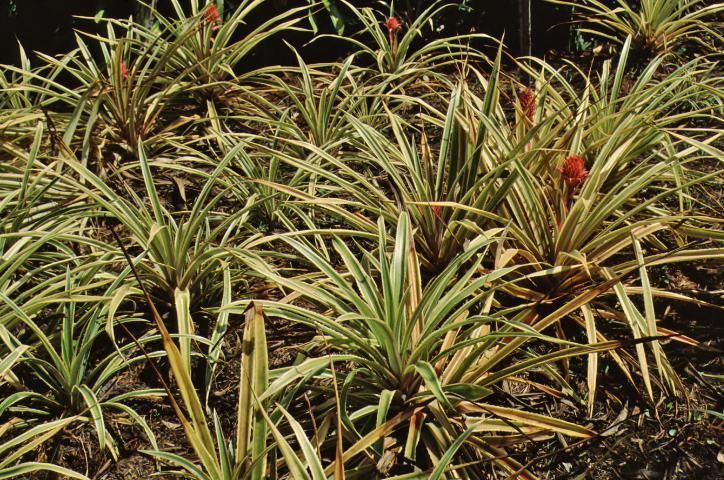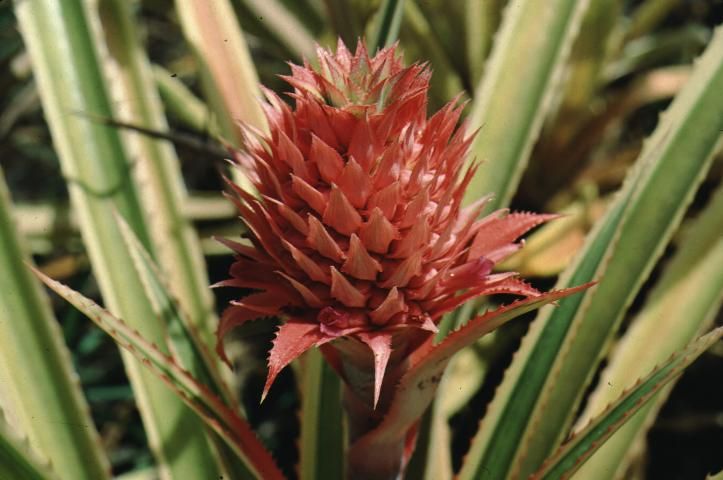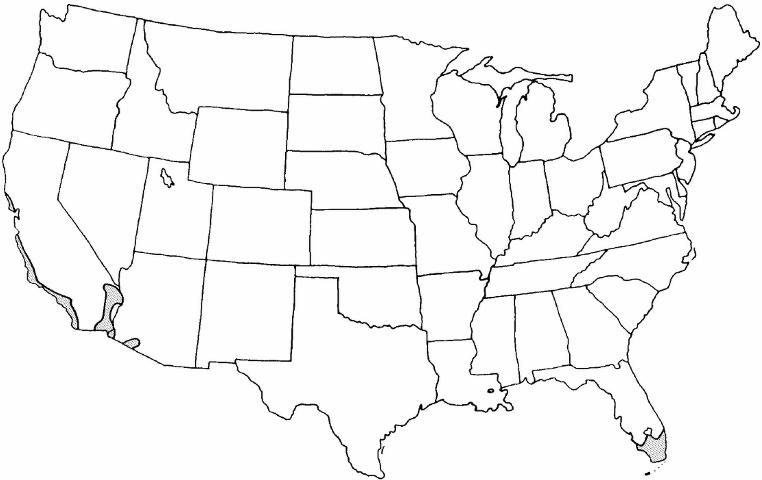Introduction
The 24- to 30-inch-long, stiff, bright green leaves have spiny tips and margins. Leaves arise from a tight rosette. Pineapples are often planted for their tropical appearance and as a horticultural novelty. The fruit appears on top of a central stalk after a year or more.

Credit: Edward F. Gilman, UF/IFAS

Credit: Edward F. Gilman, UF/IFAS
General Information
Scientific name: Ananas comosus 'Variegatus'
Pronunciation: uh-NAN-us ko-MO-sus
Common name(s): variegated pineapple
Family: Bromeliaceae
Plant type: perennial; herbaceous
USDA hardiness zones: 10 through 11 (Figure 3)

Planting month for zone 10 and 11: year-round
Origin: not native to North America
Invasive potential: not known to be invasive
Uses: ground cover; accent; specimen; border
Availablity: somewhat available, may have to go out of the region to find the plant
Description
Height: 1 to 3 feet
Spread: 3 to 5 feet
Plant habit: round
Plant density: moderate
Growth rate: slow
Texture: medium
Foliage
Leaf arrangement: most emerge from the soil, usually without a stem
Leaf type: simple
Leaf margin: spiny
Leaf shape: linear
Leaf venation: parallel
Leaf type and persistence: evergreen
Leaf blade length: 18 to 36 inches
Leaf color: variegated
Fall color: no fall color change
Fall characteristic: not showy
Flower
Flower color: red
Flower characteristic: summer-flowering
Fruit
Fruit shape: oval
Fruit length: 6 to 12 inches
Fruit cover: fleshy
Fruit color: green; yellow
Fruit characteristic: suited for human consumption; persists on the plant
Trunk and Branches
Trunk/bark/branches: usually with one stem/trunk
Current year stem/twig color: not applicable
Current year stem/twig thickness: not applicable
Culture
Light requirement: plant grows in part shade/part sun
Soil tolerances: acidic; slightly alkaline; sand; loam; clay
Drought tolerance: high
Soil salt tolerance: unknown
Plant spacing: 36 to 60 inches
Other
Roots: usually not a problem
Winter interest: no special winter interest
Outstanding plant: not particularly outstanding
Pest resistance: very sensitive to one or more pests or diseases which can affect plant health or aesthetics
Use and Management
Although the plants will tolerate full sun to fairly dark conditions inside, pineapple is most attractive as an ornamental if given some protection from full sun. Well-drained soil is most suitable for best growth. They can be used as a specimen, or grouped as a ground cover in a mass planting.
Plant on 4-foot centers to allow plants room to spread their foliage. Do not plant in areas where children play because the spines can injure them if they contact the leaves.
The cultivar 'Variegatus' is grown for its striking variegated foliage and is quite popular.
Propagation is by dividing the suckers from the base of the parent plant and also by rooting the leafy top of a mature fruit.
Design Considerations
The bold form and coarse texture of the variegated pineapple make it perfect for containers and highly visible spaces in the landscape. Use with plants that are softer with small foliage and low-growing mounding or spreading forms. Dark green foliage in the companion plants will highlight the light white and green striped leaves of the variegated pineapple. Pair with plants with more texture in the foliage to contrast with the smooth, stiff leaves. Use plants with small to medium flowers with cool, bright colors such as purples and blues to contrast with the golden color of the pineapple fruit. Use large masses of companion plants around the base or in front of the pineapples when they are planted in a mass.
Pests and Diseases
Mites, scales, and mealy-bugs can be serious pest problems.
No diseases are of major concern.